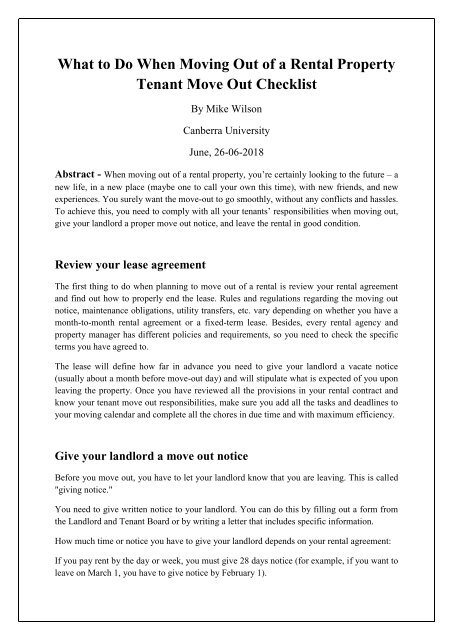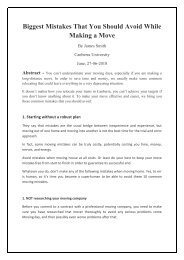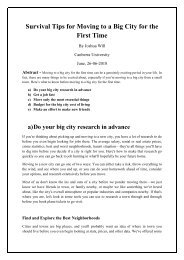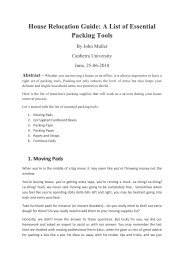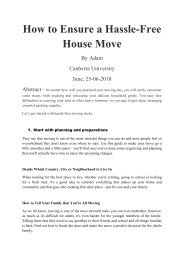What to do when moving out of a rental property tenant move out checklist
Create successful ePaper yourself
Turn your PDF publications into a flip-book with our unique Google optimized e-Paper software.
<strong>What</strong> <strong>to</strong> Do When Moving Out <strong>of</strong> a Rental Property<br />
Tenant Move Out Checklist<br />
By Mike Wilson<br />
Canberra University<br />
June, 26-06-2018<br />
Abstract - When <strong>moving</strong> <strong>out</strong> <strong>of</strong> a <strong>rental</strong> <strong>property</strong>, you’re certainly looking <strong>to</strong> the future – a<br />
new life, in a new place (maybe one <strong>to</strong> call your own this time), with new friends, and new<br />
experiences. You surely want the <strong>move</strong>-<strong>out</strong> <strong>to</strong> go smoothly, with<strong>out</strong> any conflicts and hassles.<br />
To achieve this, you need <strong>to</strong> comply with all your <strong>tenant</strong>s’ responsibilities <strong>when</strong> <strong>moving</strong> <strong>out</strong>,<br />
give your landlord a proper <strong>move</strong> <strong>out</strong> notice, and leave the <strong>rental</strong> in good condition.<br />
Review your lease agreement<br />
The first thing <strong>to</strong> <strong>do</strong> <strong>when</strong> planning <strong>to</strong> <strong>move</strong> <strong>out</strong> <strong>of</strong> a <strong>rental</strong> is review your <strong>rental</strong> agreement<br />
and find <strong>out</strong> how <strong>to</strong> properly end the lease. Rules and regulations regarding the <strong>moving</strong> <strong>out</strong><br />
notice, maintenance obligations, utility transfers, etc. vary depending on whether you have a<br />
month-<strong>to</strong>-month <strong>rental</strong> agreement or a fixed-term lease. Besides, every <strong>rental</strong> agency and<br />
<strong>property</strong> manager has different policies and requirements, so you need <strong>to</strong> check the specific<br />
terms you have agreed <strong>to</strong>.<br />
The lease will define how far in advance you need <strong>to</strong> give your landlord a vacate notice<br />
(usually ab<strong>out</strong> a month before <strong>move</strong>-<strong>out</strong> day) and will stipulate what is expected <strong>of</strong> you upon<br />
leaving the <strong>property</strong>. Once you have reviewed all the provisions in your <strong>rental</strong> contract and<br />
know your <strong>tenant</strong> <strong>move</strong> <strong>out</strong> responsibilities, make sure you add all the tasks and deadlines <strong>to</strong><br />
your <strong>moving</strong> calendar and complete all the chores in due time and with maximum efficiency.<br />
Give your landlord a <strong>move</strong> <strong>out</strong> notice<br />
Before you <strong>move</strong> <strong>out</strong>, you have <strong>to</strong> let your landlord know that you are leaving. This is called<br />
"giving notice."<br />
You need <strong>to</strong> give written notice <strong>to</strong> your landlord. You can <strong>do</strong> this by filling <strong>out</strong> a form from<br />
the Landlord and Tenant Board or by writing a letter that includes specific information.<br />
How much time or notice you have <strong>to</strong> give your landlord depends on your <strong>rental</strong> agreement:<br />
If you pay rent by the day or week, you must give 28 days notice (for example, if you want <strong>to</strong><br />
leave on March 1, you have <strong>to</strong> give notice by February 1).
If you pay rent by the month, you must generally give 60 days notice.<br />
If your lease is fixed for a period longer than a month, you must generally give 60 days<br />
notice.<br />
When you give notice, you have <strong>to</strong> let your landlord know what day you want <strong>to</strong> end your<br />
tenancy. This must be the last day <strong>of</strong> the <strong>rental</strong> period. For example, if you pay rent by the<br />
month, the last day <strong>of</strong> your tenancy must be the last day <strong>of</strong> the month.<br />
If you are a victim <strong>of</strong> <strong>do</strong>mestic or sexual abuse, you can leave your <strong>rental</strong> unit by providing<br />
28 days notice. Under these circumstances, it <strong>do</strong>es not matter what type <strong>of</strong> <strong>rental</strong> agreement<br />
you have and you can give notice at any time.<br />
You can contact a legal clinic or housing help centre for more information. To find help in<br />
your area, go <strong>to</strong> Services near Me.<br />
Inspect the <strong>property</strong> and fix damage<br />
Now that you have found and screened a <strong>tenant</strong> <strong>to</strong> fill the vacancy at your <strong>rental</strong>, the next step<br />
is <strong>to</strong> actually have the <strong>tenant</strong> <strong>move</strong> in<strong>to</strong> your <strong>property</strong>. There are certain steps every landlord<br />
should take <strong>to</strong> help make this transition as smooth as possible. If you get in<strong>to</strong> the habit <strong>of</strong><br />
checking <strong>of</strong>f these ten items every time a new <strong>tenant</strong> <strong>move</strong>s in, the process will be easier for<br />
both you and the <strong>tenant</strong>, and misunderstandings and complaints will be minimized.<br />
1. Repair Any Damage or Health and Safety Issues<br />
Before a <strong>tenant</strong> <strong>move</strong>s in, you will want <strong>to</strong> repair any existing damage at the <strong>property</strong>.<br />
Damage could include a hole in the wall or a broken win<strong>do</strong>w lock.<br />
You will also want <strong>to</strong> make sure there are no health or safety issues. Safety issues include<br />
verifying that there are two forms <strong>of</strong> exit from the unit and that all carbon monoxide and<br />
smoke detec<strong>to</strong>rs are in working order. Health issues include checking for signs <strong>of</strong> mold and,<br />
for buildings constructed before 1978, that there are no lead-based paint hazards.<br />
This maintenance is necessary for the health and safety <strong>of</strong> the <strong>tenant</strong>. It also helps <strong>to</strong> ensure<br />
that you pass any <strong>property</strong> inspections required before the <strong>tenant</strong> <strong>move</strong>s in.<br />
2. Clean the Property<br />
This is especially necessary if you are <strong>do</strong>ing an apartment turnover, which means there was a<br />
previous <strong>tenant</strong> living in the unit. You will want <strong>to</strong> make sure the unit is thoroughly cleaned,<br />
especially areas such as the tub, <strong>to</strong>ilet, s<strong>to</strong>ve, and refrigera<strong>to</strong>r.
Even if this is the first time you are renting <strong>out</strong> the unit and everything is brand new, you<br />
should still vacuum or sweep <strong>to</strong> re<strong>move</strong> any debris. You should also have the <strong>property</strong><br />
exterminated before <strong>tenant</strong> <strong>move</strong>-in even if there is no noticeable problem.<br />
3. Make Sure Heat, Plumbing and Electric Are Working<br />
Before a <strong>tenant</strong> <strong>move</strong>s in, you must make sure all utilities are working. You will need <strong>to</strong> <strong>do</strong><br />
this whether you are responsible for paying for the utilities or whether the <strong>tenant</strong> is<br />
responsible for paying for them.<br />
You will want <strong>to</strong> make sure the heat works in all rooms, that there are no clogs or leaks in the<br />
plumbing and that the <strong>out</strong>lets and overhead lights in every room are operational. These are<br />
necessities that a <strong>tenant</strong> needs <strong>to</strong> maintain their quality <strong>of</strong> life.<br />
4. Go over the Lease and Have the Tenant Sign the Lease<br />
You should go over the lease agreement with the <strong>tenant</strong> section by section so that they<br />
completely understand what they are agreeing <strong>to</strong>. Once you have gone over the entire<br />
agreement with the <strong>tenant</strong> and answered any questions, you and the <strong>tenant</strong> should sign and<br />
date the lease agreement.<br />
5. Collect First Month’s Rent and Security Deposit<br />
You should always collect the first month’s rent and the entire security deposit before the<br />
<strong>tenant</strong> <strong>move</strong>s in<strong>to</strong> the unit. If the <strong>tenant</strong> <strong>do</strong>es not pay on time the first month, it increases the<br />
likelihood that they will be late with their <strong>rental</strong> payments the following months.<br />
The exception <strong>to</strong> collecting the first month's rent prior <strong>to</strong> the <strong>tenant</strong>'s <strong>move</strong> in would be if the<br />
<strong>tenant</strong> is receiving government assistance, such as Section 8. Section 8 will send you the<br />
check once the <strong>tenant</strong> has <strong>move</strong>d in<strong>to</strong> the unit. However, Section 8 <strong>tenant</strong>s are still<br />
responsible for paying their own security deposit. You should still collect this deposit prior <strong>to</strong><br />
the <strong>tenant</strong>'s <strong>move</strong>-in.<br />
6. Have Property Inspected if Required<br />
Depending on your <strong>to</strong>wn’s laws, you may have <strong>to</strong> have the unit inspected before a <strong>tenant</strong> can<br />
<strong>move</strong> in<strong>to</strong> the unit. This inspection is <strong>do</strong>ne so the <strong>to</strong>wn can issue you a Certificate <strong>of</strong><br />
Habitability. Some <strong>to</strong>wns only require this inspection the first time the unit is rented, some<br />
<strong>to</strong>wns require it every five years and some require it every time a new <strong>tenant</strong> <strong>move</strong>s in<strong>to</strong> the<br />
unit. Make sure you know your <strong>to</strong>wn’s rules.
If you are renting <strong>to</strong> a Section 8 <strong>tenant</strong>, the apartment will have <strong>to</strong> be inspected by a Section 8<br />
inspec<strong>to</strong>r <strong>to</strong> make sure it meets their health and safety standards. Section 8 requires the unit <strong>to</strong><br />
be inspected every year that the Section 8 <strong>tenant</strong> lives there.<br />
7. Change Locks<br />
Before a new <strong>tenant</strong> <strong>move</strong>s in, you should always change the locks on the <strong>do</strong>ors. This is <strong>do</strong>ne<br />
for the safety <strong>of</strong> the <strong>tenant</strong> and <strong>to</strong> protect you from liability. You <strong>do</strong> not want an old <strong>tenant</strong> <strong>to</strong><br />
have the keys <strong>to</strong> the new <strong>tenant</strong>’s apartment. Spend the $20 on a new lock <strong>to</strong> avoid any<br />
issues.<br />
8. Go Through Move-In Checklist<br />
On the <strong>tenant</strong>’s actual <strong>move</strong>-in day, you should go over the <strong>move</strong>-in <strong>checklist</strong> with the <strong>tenant</strong>.<br />
The <strong>checklist</strong> describes the condition <strong>of</strong> the <strong>property</strong> as a whole and <strong>of</strong> each room in detail.<br />
You should have the <strong>tenant</strong> sign and date this <strong>checklist</strong>. The <strong>move</strong>-in <strong>checklist</strong> is important as<br />
it allows you <strong>to</strong> compare the condition <strong>of</strong> the <strong>property</strong> <strong>when</strong> the <strong>tenant</strong> <strong>move</strong>s in, <strong>to</strong> the<br />
condition <strong>of</strong> the <strong>property</strong> <strong>when</strong> the <strong>tenant</strong> <strong>move</strong>s <strong>out</strong>.<br />
9. Provide Tenant With Your Contact Information<br />
You should provide the <strong>tenant</strong> with your contact information. This will be the method <strong>of</strong><br />
communication which allows them <strong>to</strong> reach you if they have a question or complaint. It can<br />
be a phone number or an email address, but make sure they know <strong>to</strong> only contact you during<br />
normal business hours, 9 A.M. <strong>to</strong> 5 P.M. unless it is an absolute emergency.<br />
10. Go Through Any Specific Tenant Requests or Conditions<br />
There are situations where a <strong>tenant</strong> may have a specific request or special requirements that<br />
are not typical. Some examples could be:<br />
<br />
<br />
<br />
<br />
Having the Apartment Painted a Certain Color<br />
Installing a Washer/Dryer Prior <strong>to</strong> Move In<br />
Receiving a Government Assistance Housing Voucher<br />
A Disability Which Requires a Service Animal<br />
In the situations such as the government assistance and the service <strong>do</strong>g, you are legally<br />
responsible <strong>to</strong> take the appropriate steps <strong>to</strong> accommodate the <strong>tenant</strong>. In the situations that are<br />
more desirable than necessity, it is up <strong>to</strong> you <strong>to</strong> decide if you would like <strong>to</strong> honor the request.<br />
You should make sure <strong>to</strong> add any special requests as a clause in your lease agreement. For<br />
example, if you are going <strong>to</strong> charge the <strong>tenant</strong> $500 <strong>to</strong> paint the apartment, you need <strong>to</strong>
include this in your lease so that you have written the pro<strong>of</strong> that the <strong>tenant</strong> has agreed <strong>to</strong> these<br />
terms.<br />
Pay <strong>of</strong>f your bills<br />
Your landlord has the legal right <strong>to</strong> use your deposit money for any unpaid charges and bills,<br />
so make sure you pay <strong>of</strong>f any due taxes and fees before <strong>moving</strong> <strong>out</strong> <strong>of</strong> the <strong>rental</strong> – waste<br />
management fees, utility bills (for gas, electricity, and water), service fees (for Internet, cable<br />
TV, and phone), etc. Inform all your service providers that you’re <strong>moving</strong> <strong>out</strong> and arrange the<br />
services at your <strong>rental</strong> <strong>to</strong> be disconnected on the day after your <strong>move</strong> (unless you have a<br />
different agreement with your landlord) and the utilities in your new home <strong>to</strong> be turned on by<br />
<strong>move</strong>-in day. Don’t forget <strong>to</strong> take readings <strong>of</strong> all gas, electricity, and water meters on <strong>moving</strong><br />
day and pho<strong>to</strong>graph them for pro<strong>of</strong>. (See also: How <strong>to</strong> transfer utilities <strong>when</strong> <strong>moving</strong>)<br />
Unless you can pay online, leave enough money for any bills that are due at a time <strong>when</strong> you<br />
will already be away.<br />
Take all your things <strong>out</strong> <strong>of</strong> the <strong>rental</strong><br />
Make sure you <strong>do</strong>n’t leave any <strong>of</strong> your stuff behind – you’re going <strong>to</strong> pack your belongings<br />
and <strong>move</strong> them <strong>to</strong> your new home, <strong>of</strong> course, but there may be some things you <strong>do</strong>n’t want <strong>to</strong><br />
take with you or some things you may completely forget ab<strong>out</strong>. None <strong>of</strong> them should remain<br />
in the <strong>rental</strong> <strong>property</strong> though, as your landlord can charge you for having <strong>to</strong> take <strong>out</strong> and<br />
dispose <strong>of</strong> your stuff. So, make sure you:<br />
<br />
<br />
<br />
<br />
Sort <strong>out</strong> your possessions a couple <strong>of</strong> months before your <strong>move</strong> and find a way <strong>to</strong> get<br />
rid <strong>of</strong> everything you <strong>do</strong>n’t want anymore – sell or <strong>do</strong>nate useful items that are still in<br />
good condition, throw away damaged items and items that are <strong>to</strong>o worn <strong>out</strong> <strong>to</strong> be used<br />
ever again, recycle whatever you can, etc.;<br />
Remember <strong>to</strong> take <strong>do</strong>wn pictures and calendars from the walls, re<strong>move</strong> stickers and<br />
magnets from the fridge, get all your items from the bathroom (shower curtains, mats,<br />
<strong>to</strong>wels, <strong>to</strong>iletries, etc.), pack decorations and hobby materials, take your <strong>do</strong>or mats<br />
and rugs, <strong>to</strong>ols and flower pots, etc.;<br />
Open drawers and cupboards, look in the l<strong>of</strong>t and under the stairs, go through the<br />
basement and the garage, walk around the yard – just <strong>do</strong>uble-check everything;<br />
Take <strong>out</strong> all the trash.<br />
Don’t forget that cleaning supplies, laundry supplies, hazar<strong>do</strong>us materials (paints, fuel<br />
supplies, etc.), trash cans, and anything else that was not in the <strong>rental</strong> unit <strong>when</strong> you <strong>move</strong>d in<br />
has <strong>to</strong> go as well.
Clean thoroughly<br />
1. Re<strong>move</strong> all your <strong>property</strong> from the unit. Take <strong>out</strong> everything that you brought in<strong>to</strong> the<br />
house or apartment, including wall-mounted decorations and shelving units. Re<strong>move</strong><br />
pictures, posters and decals from the walls. Check the closets and cabinets <strong>to</strong> make sure you<br />
haven’t left anything behind.<br />
2. Clean your walls. Check your walls carefully and re<strong>move</strong> any tape, nails, picture hangers,<br />
or poster gum. Check for dirt, marks and smudges, especially if you have small children in<br />
the house. Use a duster <strong>to</strong> re<strong>move</strong> cobwebs. Scrub dirty areas with a gentle cleanser and a rag<br />
or s<strong>of</strong>t sponge.<br />
On latex paints, use a solution <strong>of</strong> water with a few drops <strong>of</strong> dish detergent, or a gallon (3.8<br />
liters) <strong>of</strong> water mixed with 3-4 tablespoons (45-60 ml) <strong>of</strong> white vinegar.<br />
On <strong>to</strong>ugher oil-based paints, like those used in kitchens, you can use a gentle degreaser.<br />
Use caution <strong>when</strong> cleaning around electrical fixtures, like light switches and <strong>out</strong>let covers.<br />
Wring your sponge <strong>out</strong> carefully before attempting <strong>to</strong> clean these surfaces. You may wish <strong>to</strong><br />
switch <strong>of</strong>f your electricity at the circuit breaker before cleaning a dirty <strong>out</strong>let cover.<br />
3. Clean your appliances. Use an all-purpose cleaner (like Formula 409) or specialized<br />
kitchen cleanser (like Bar Keepers Friend) and a gentle sponge or Magic Eraser <strong>to</strong> scrub your<br />
s<strong>to</strong>ve, refrigera<strong>to</strong>r, and dishwasher (if you have one). If you can, re<strong>move</strong> bins and racks from<br />
your fridge and oven and wash them in the sink with a gentle detergent or a solution <strong>of</strong> warm<br />
water and baking soda.<br />
4. Clean your plumbing fixtures. Take special care <strong>to</strong> clean your bathtub, shower, <strong>to</strong>ilet, and<br />
sinks. Use Comet or a similar cleanser for plumbing fixtures, along with a gentle scrubber or<br />
magic eraser, <strong>to</strong> clean <strong>of</strong>f soap scum, stains, and hard water deposits. For especially stubborn<br />
stains or deposits, you may need <strong>to</strong> let the cleanser sit for several minutes before you start<br />
scrubbing.<br />
A little bit <strong>of</strong> white vinegar mixed with water is also excellent for re<strong>moving</strong> lime and soap<br />
scum.<br />
5. Clean your counters and cabinets. Wipe <strong>do</strong>wn your counters and the exteriors <strong>of</strong> your<br />
cabinets with a gentle cleanser and a rag or sponge. Areas around the handles <strong>of</strong> cabinets are<br />
especially prone <strong>to</strong> getting smudged and grimy. Don’t forget <strong>to</strong> clean <strong>out</strong> the insides <strong>of</strong> your<br />
cabinets, as well. For <strong>to</strong>ugh spots, use a mildly abrasive mixture <strong>of</strong> baking soda and water,<br />
and scrub with a s<strong>of</strong>t brush.<br />
6. Wipe <strong>do</strong>wn your mirrors and win<strong>do</strong>ws. Spray your mirrors and win<strong>do</strong>ws with a glass<br />
cleaner (like Windex) and wipe them clean with a rag or sponge, making sure not <strong>to</strong> leave<br />
behind streaks or lint. You can also clean glass surfaces with a mixture <strong>of</strong> white vinegar and<br />
hot water.
7. Sweep and vacuum your floors. You may wish <strong>to</strong> save cleaning your floors for last, since<br />
cleaning walls and other surfaces can create a mess on the floor. Once you are ready, wipe up<br />
any wet spots on the floors. Sweep hard floor surfaces clean with a broom and dustpan.<br />
Vacuum any carpeted surfaces.<br />
8. Mop your floors. Once you have swept, mop any hard floor surfaces with a traditional push<br />
mop or a steam mop. In areas that are especially prone <strong>to</strong> messy floors, like kitchens and<br />
bathrooms, you may wish <strong>to</strong> go over the floor more than once. Scrub any extra stubborn spots<br />
with a scrub brush and detergent.<br />
Take extra care <strong>when</strong> cleaning hardwood floors. Ask your landlord or <strong>property</strong> manager what<br />
type <strong>of</strong> finish is on your floor and get appropriate cleansers before attempting <strong>to</strong> clean it<br />
thoroughly.<br />
9. Clean your carpets. After vacuuming any carpeted surfaces, you may wish <strong>to</strong> spot clean or<br />
shampoo them. Purchase a carpet cleaning solution, like Resolve or Zep. Test it in a discreet<br />
area <strong>to</strong> make sure that it <strong>do</strong>es not damage, bleach, or stain your carpet. Spot clean with a<br />
clean, white rag. For cleaning larger areas, you can purchase or rent a carpet shampooer.<br />
Some landlords may prefer <strong>to</strong> bring in a pr<strong>of</strong>essional carpet cleaning service after their<br />
<strong>tenant</strong>s <strong>move</strong> <strong>out</strong>, so you should discuss this with your landlord before calling in anyone <strong>to</strong><br />
clean your carpet for you.<br />
Document the condition <strong>of</strong> the <strong>rental</strong> <strong>property</strong><br />
As a <strong>tenant</strong> you have rights under the Residential Tenancies Act 2010 and Residential<br />
Tenancies Regulation 2010. This factsheet <strong>out</strong>lines NSW residential tenancies law.<br />
<strong>What</strong> the Act means for <strong>tenant</strong>s<br />
Most residential tenancies in NSW are covered by the Residential Tenancies Act 2010<br />
(‘the Act’)<br />
The Act and the regulations set <strong>out</strong> a standard residential tenancy agreement that<br />
gives rights and obligations <strong>to</strong> landlords and <strong>tenant</strong>s.<br />
The Act gives the NSW Civil and Administrative Tribunal (NCAT) power <strong>to</strong> hear and<br />
settle disputes ab<strong>out</strong> residential tenancies, including bond disputes.<br />
Who the Act covers<br />
<br />
<br />
Private <strong>tenant</strong>s who have a written or oral residential tenancy agreement<br />
social housing <strong>tenant</strong>s, including <strong>tenant</strong>s <strong>of</strong> Housing NSW, community housing<br />
providers and the Aboriginal Housing Office. Social housing providers have certain<br />
specific rights and obligations under the Act
People who rent a home in a residential park<br />
Who/what the Act <strong>do</strong>es not cover<br />
People who own a home and rent a site in a residential park are covered by the<br />
Residential (Land Lease) Communities Act 2013. (see thenoticeboard.org.au for<br />
factsheets)<br />
‘protected’ <strong>tenant</strong>s under the Landlord and Tenant (Amendment) Act 1948<br />
residential aged-care or respite-care premises<br />
serviced apartments, hotels, motels and backpackers hostels<br />
hospitals and nursing homes<br />
club premises used <strong>to</strong> provide temporary accommodation<br />
premises used mostly for the purpose <strong>of</strong> trade, pr<strong>of</strong>ession, business or agriculture<br />
holiday parks occupation agreements<br />
retirement village residence contracts<br />
refuge or crisis accommodation agreements<br />
boarding and lodging agreements (see Factsheet 14: Boarders and lodgers)<br />
agreements giving the right <strong>to</strong> occupy residential premises for no more than 3 months<br />
for a holiday.<br />
It also <strong>do</strong>es not apply:<br />
<br />
<br />
<br />
<br />
where a <strong>tenant</strong> made an agreement in good faith for the sale, purchase or mortgage <strong>of</strong><br />
the residential premises<br />
where a <strong>tenant</strong> is a shareholder living in company title premises<br />
where a tenancy agreement is part <strong>of</strong> an equity purchase agreement which gives the<br />
<strong>tenant</strong> an option <strong>to</strong> buy<br />
<strong>to</strong> most family arrangements.<br />
Your rights under the Act<br />
To be given a copy <strong>of</strong> the residential tenancy agreement, a condition report completed<br />
by the landlord/agent and the NSW Fair Trading New <strong>tenant</strong> <strong>checklist</strong><br />
<strong>to</strong> have premises rented <strong>to</strong> you in a reasonable state <strong>of</strong> cleanliness and fit <strong>to</strong> live in<br />
<strong>to</strong> be given rent receipts (unless you pay rent in<strong>to</strong> a nominated bank account)<br />
<strong>to</strong> be <strong>of</strong>fered at least one means <strong>of</strong> paying the rent for which you <strong>do</strong> not incur a cost<br />
<strong>to</strong> be given 60 days written notice <strong>of</strong> a rent increase<br />
<strong>to</strong> have quiet enjoyment and use <strong>of</strong> the premises – the landlord/agent must not<br />
interfere with your possession <strong>of</strong> the premises<br />
<strong>to</strong> have reasonable peace, comfort and privacy<br />
<strong>to</strong> have reasonable locks and security<br />
<strong>to</strong> have reasonable repairs and maintenance <strong>do</strong>ne<br />
<strong>to</strong> be repaid for any urgent repairs that you have paid for – up <strong>to</strong> $1000<br />
<strong>to</strong> apply <strong>to</strong> NCAT for orders if the landlord has broken the tenancy agreement
<strong>to</strong> be given written notice <strong>of</strong> the landlord wanting <strong>to</strong> end the tenancy agreement<br />
<strong>to</strong> be notified <strong>of</strong> the change <strong>of</strong> name and address <strong>of</strong> the landlord or their agent<br />
<strong>to</strong> refuse the landlord access except in certain circumstances and with proper notice<br />
not <strong>to</strong> be unlawfully evicted.<br />
Your obligations under the Act<br />
<br />
<br />
<br />
<br />
<br />
<br />
<br />
<br />
<br />
<br />
<br />
<br />
To fill <strong>out</strong> the condition report and give the landlord/agent a copy within 7 days<br />
<strong>to</strong> pay rent on time<br />
<strong>to</strong> care for the premises<br />
<strong>to</strong> pay for any damage caused by you or your guests<br />
<strong>to</strong> report the need for any repairs or maintenance<br />
not <strong>to</strong> make alterations or additions with<strong>out</strong> the landlord’s permission<br />
not <strong>to</strong> alter, re<strong>move</strong> or add a lock or security device with<strong>out</strong> the landlord’s consent<br />
(except in certain <strong>do</strong>mestic violence situations)<br />
not <strong>to</strong> use or permit the premises <strong>to</strong> be used for an illegal purpose<br />
not <strong>to</strong> cause or permit a nuisance<br />
not <strong>to</strong> interfere with the peace, comfort or privacy <strong>of</strong> neighbours<br />
<strong>to</strong> give correct written notice <strong>when</strong> you leave<br />
<strong>to</strong> leave the premises in a similar condition <strong>to</strong> <strong>when</strong> you rented them, except for<br />
normal wear and tear.<br />
Terms <strong>of</strong> the standard tenancy agreement<br />
The Act says that landlords must use the standard terms set <strong>out</strong> in the Residential Tenancies<br />
Regulation 2010. Many <strong>of</strong> the terms are the same as those listed above.<br />
The terms <strong>of</strong> the standard residential tenancy agreement cannot be varied (except for tenancy<br />
agreements that are for a fixed term <strong>of</strong> 20 years or more – contact your local Tenants Advice<br />
and Advocacy Service for more information).<br />
If you <strong>do</strong> not carry <strong>out</strong> your responsibilities you can be said <strong>to</strong> have ‘breached’ (broken)<br />
term/s <strong>of</strong> the agreement.<br />
Prohibited terms<br />
Section 19(2) <strong>of</strong> the Act says: “Terms having the following effects must not be included in a<br />
residential tenancy agreement:<br />
<br />
<br />
<br />
That the <strong>tenant</strong> must have the carpet pr<strong>of</strong>essionally cleaned, or pay the cost <strong>of</strong> such<br />
cleaning, at the end <strong>of</strong> the tenancy [unless the cleaning is required because animals<br />
have been kept on the premises during the tenancy],<br />
That the <strong>tenant</strong> must take <strong>out</strong> a specified, or any, form <strong>of</strong> insurance,<br />
Exempting the landlord from liability for any act or omission by the landlord, the<br />
landlord’s agent or any person acting on behalf <strong>of</strong> the landlord or landlord’s agent,
That, if the <strong>tenant</strong> breaches the agreement, the <strong>tenant</strong> is liable <strong>to</strong> pay all or any part <strong>of</strong><br />
the remaining rent under the agreement, increased rent, a penalty or liquidated<br />
damages,<br />
That, if the <strong>tenant</strong> <strong>do</strong>es not breach the agreement, the rent is or may be reduced or the<br />
<strong>tenant</strong> is <strong>to</strong> be or may be paid a rebate <strong>of</strong> rent or other benefit.”<br />
In addition, the Regulation says:<br />
“A residential tenancy agreement must not contain a term having the effect that the <strong>tenant</strong><br />
must use the services <strong>of</strong> a specified person or business <strong>to</strong> carry <strong>out</strong> any <strong>of</strong> the <strong>tenant</strong>’s<br />
obligations under the agreement.”<br />
Inconsistent and prohibited terms are void<br />
A term is void if it is:<br />
<br />
<br />
Inconsistent with any term <strong>of</strong> the standard residential tenancy agreement, or<br />
Prohibited by the Act or Regulation.<br />
Additional terms<br />
Additional terms may included in the standard residential tenancy agreement if:<br />
<br />
<br />
<br />
Both you and the landlord agree <strong>to</strong> them<br />
They <strong>do</strong> not conflict with the Residential Tenancies Act 2010 or any other legislation<br />
They <strong>do</strong> not conflict with the terms <strong>of</strong> the standard agreement.<br />
If you are unsure ab<strong>out</strong> an additional term, get advice from your local Tenants Advice and<br />
Advocacy Service or apply <strong>to</strong> NCAT for an order that the term is invalid.<br />
Arrange a <strong>move</strong> <strong>out</strong> inspection<br />
Every <strong>move</strong>-<strong>out</strong> <strong>checklist</strong> for <strong>tenant</strong>s ends with scheduling a final inspection. So, <strong>do</strong>n’t forget<br />
<strong>to</strong> call your landlord a week or so before leaving the <strong>property</strong> and ask him/her <strong>to</strong> conduct a<br />
<strong>move</strong>-<strong>out</strong> walkthrough <strong>of</strong> the <strong>rental</strong> unit <strong>to</strong> see whether any security deposit deductions are<br />
justified. Be present at the <strong>move</strong>-<strong>out</strong> inspection, discuss any issues that may arise, try <strong>to</strong> find<br />
mutually beneficial solutions, and request your tenancy deposit back.<br />
Get your security deposit back<br />
When you <strong>move</strong> <strong>out</strong> <strong>of</strong> a <strong>rental</strong> <strong>property</strong>, you’re legally entitled <strong>to</strong> get your tenancy deposit<br />
back (unless you have <strong>do</strong>ne extensive damage or violated the terms <strong>of</strong> your lease agreement).
You already know what <strong>to</strong> <strong>do</strong> <strong>when</strong> <strong>moving</strong> <strong>out</strong> <strong>of</strong> a <strong>rental</strong> <strong>to</strong> avoid deposit deductions – all<br />
that is left <strong>to</strong> <strong>do</strong> now is send a written request by certified mail (with return receipt requested)<br />
<strong>to</strong> your former landlord (keep in mind that you’re required <strong>to</strong> provide your new address in<br />
your request). Depending on your state law, the landlord will have two <strong>to</strong> three weeks after<br />
receiving the letter <strong>to</strong> either return your deposit money or provide a written statement <strong>of</strong><br />
deductions (for unpaid utility bills, repairing damaged items, cleaning the <strong>property</strong>, etc.).<br />
If there’s no response or if you disagree with your landlord’s statement, you might need <strong>to</strong> go<br />
<strong>to</strong> small claims court <strong>to</strong> settle the issue.<br />
Conclusion<br />
Whether you’re <strong>moving</strong> <strong>out</strong> <strong>of</strong> a <strong>rental</strong> or your own <strong>property</strong>, <strong>moving</strong> house is a difficult and<br />
stressful process that requires a lot <strong>of</strong> careful planning, meticulous organization, and hard<br />
work. Make sure you research all your options, plan your <strong>move</strong> well, find affordable and<br />
trustworthy <strong>moving</strong> partners <strong>to</strong> work with, book their services as early as possible, pack<br />
safely and efficiently, take care <strong>of</strong> all the necessary <strong>moving</strong> tasks and preparations, and<br />
ensure a smooth and successful relocation. Happy new life in your new home!<br />
References<br />
ETHAN GREENFIELDON(2018) | <strong>What</strong> <strong>to</strong> <strong>do</strong> <strong>when</strong> <strong>moving</strong> <strong>out</strong> <strong>of</strong> a <strong>rental</strong> <strong>property</strong>: <strong>tenant</strong><br />
<strong>move</strong> <strong>out</strong> <strong>checklist</strong> | Moving Tips. Retrieved on 26-06-2018 from<br />
https://<strong>moving</strong>.tips/pre-<strong>move</strong>-tips/<strong>tenant</strong>-<strong>move</strong>-<strong>out</strong>-<strong>checklist</strong>/<br />
(2016) | When <strong>do</strong> I have <strong>to</strong> tell my landlord that I am <strong>moving</strong> <strong>out</strong>? | Settlement. Retrieved on<br />
26-06-2018 from<br />
https://settlement.org/ontario/housing/rent-a-home/<strong>tenant</strong>-rights-and-responsibilities/<strong>when</strong><strong>do</strong>-i-have-<strong>to</strong>-tell-my-landlord-that-i-am-<strong>moving</strong>-<strong>out</strong>/<br />
ERIN EBERLIN(2018) | 10 Items Landlords Must Check Off Before Tenant Move | The<br />
Balance Small Business. Retrieved on 26-06-2018 from<br />
https://www.thebalancesmb.com/landlord-actions-before-<strong>move</strong>-in-2125027<br />
BetterRemovalistsCanberra(2017) | 5 Major Differences Between Good and Bad Removalists<br />
in Canberra | Better Removalists Canberra. Retrieved on 26-06-2018 from
https://www.betterremovalistscanberra.com.au/5-major-differences-good-bad-removalists-canberra/<br />
How <strong>to</strong> Leave a Rental Unit in Good Condition | Wiki How. Retrieved on 26-06-2018 from<br />
https://www.wikihow.com/Leave-a-Rental-Unit-in-Good-Condition<br />
The Residential Tenancies Act | <strong>tenant</strong>s. Retrieved on 26-06-2018 from<br />
https://www.<strong>tenant</strong>s.org.au/factsheet-01-residential-tenancies-act


